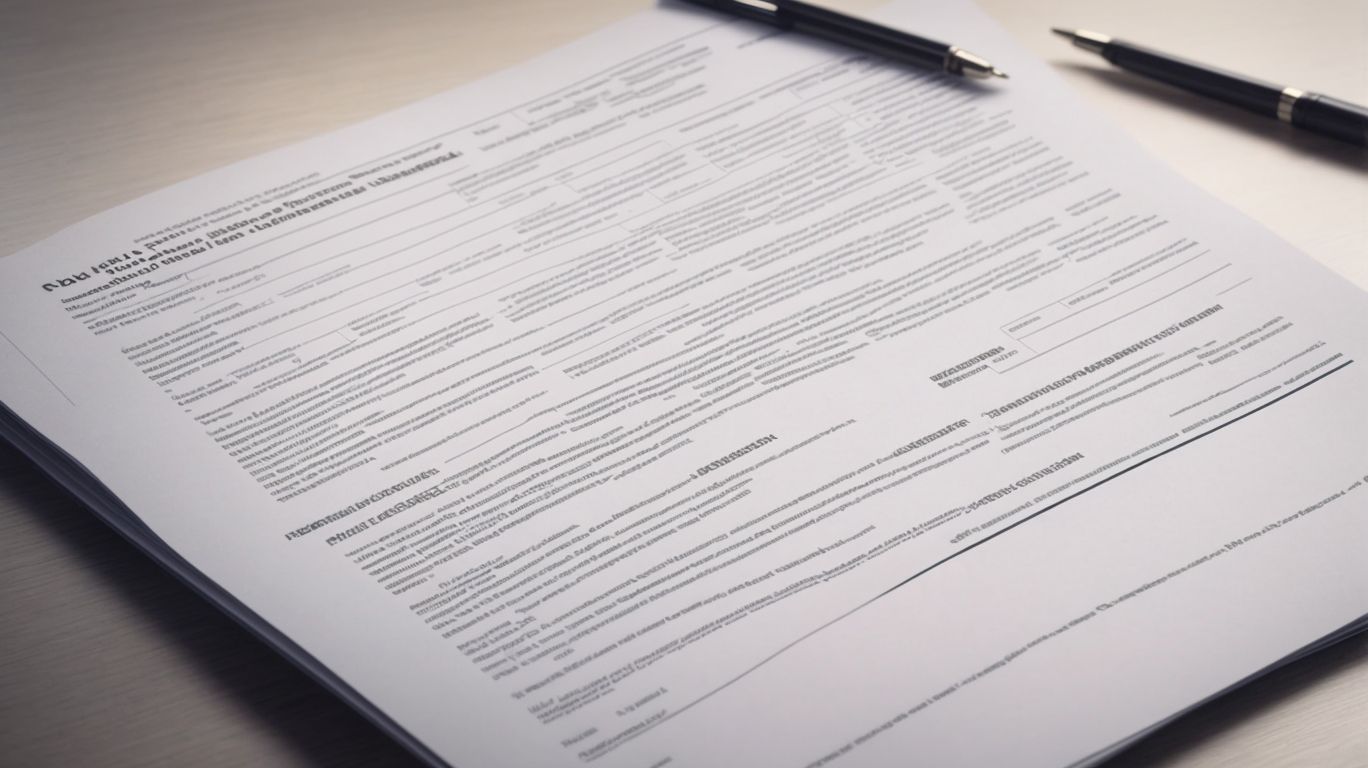Are you familiar with the concept of a patient information sheet and its significance in healthcare? This article will explore the importance of a patient information sheet, what key details should be included, and how to create an effective one.
In addition, a case study example in the field of psychology will be presented to showcase the steps involved in designing a comprehensive patient information sheet. Let’s dive into the world of patient information sheets and discover how they can enhance patient care.
Contents
- 1 What Is a Patient Information Sheet?
- 2 Why Is a Patient Information Sheet Important?
- 3 What Should Be Included in a Patient Information Sheet?
- 4 How to Create an Effective Patient Information Sheet?
- 5 Case Study: Creating a Patient Information Sheet in Psychology
- 6 Frequently Asked Questions
- 6.1 What is a patient information sheet?
- 6.2 Why is it important to create a patient information sheet?
- 6.3 What are the key elements of a patient information sheet?
- 6.4 How can a patient information sheet be used in psychology?
- 6.5 What are some tips for creating an effective patient information sheet?
- 6.6 Is a patient information sheet confidential?
What Is a Patient Information Sheet?
A patient information sheet is a document that contains essential details about an individual’s medical history, current health status, and emergency contacts.
Having this information readily available is crucial for healthcare providers to offer personalized care tailored to the specific needs of each patient.
By including details such as allergies, medications, past surgeries, and ongoing medical conditions, these sheets enable healthcare professionals to make informed decisions quickly and efficiently.
In emergency situations, having immediate access to emergency contact information can be lifesaving, ensuring that the right people are notified promptly.
Why Is a Patient Information Sheet Important?
A patient information sheet holds vital importance in the healthcare setting as it provides healthcare professionals with crucial details necessary for accurate diagnosis and treatment.
These sheets serve as a bridge of communication between patients and healthcare providers, ensuring that all pertinent information about medical history, symptoms, and previous treatments is shared. This exchange of information plays a key role in enhancing the accuracy of diagnoses and tailoring treatment plans to individual needs. By allowing healthcare professionals to have a comprehensive understanding of a patient’s condition, these sheets contribute significantly to improving treatment outcomes.
What Should Be Included in a Patient Information Sheet?
A comprehensive patient information sheet should encompass details such as the individual’s medical history, current medications, and known allergies to facilitate efficient and personalized healthcare.
Providing a thorough medical history not only assists healthcare providers in understanding the patient’s overall health but also aids in identifying any potential risks or contraindications with new treatments. Including a detailed list of current medications is crucial for preventing adverse drug interactions and ensuring proper dosage adjustments. Documenting known allergies is vital to avoid allergic reactions that could jeopardize the patient’s well-being during medical procedures or medication administration. In essence, a patient information sheet serves as a critical tool for healthcare professionals to deliver safe and effective care.
Basic Personal Information
Basic personal information is foundational in a patient information sheet as it provides healthcare providers with essential details about the individual, including their name, age, and contact information.
Having these basic personal details readily available allows healthcare providers to accurately identify and communicate with patients.
Names ensure the patient’s identification within the healthcare system, while age helps in tailoring treatment plans to meet specific needs or considerations.
Contact information such as phone numbers or addresses plays a crucial role in follow-up appointments, reaching out in case of emergencies, and obtaining consent when necessary.
Medical History
An individual’s medical history is a critical component of a patient information sheet, providing insights into past illnesses, treatments, and family medical background.
Having a comprehensive medical history enables healthcare providers to make informed decisions when diagnosing conditions and creating personalized treatment plans. By understanding past health issues, doctors can better interpret current symptoms and tailor interventions to meet specific patient needs. Furthermore, documenting family medical background helps in identifying hereditary health risks that might influence potential illnesses or conditions. This proactive approach allows for early detection and preventative measures, ultimately enhancing patient care and promoting overall well-being.
Current Medications
Listed on a patient information sheet, current medications are essential for healthcare professionals to ensure safe treatment plans, avoid drug interactions, and monitor patient adherence.
Keeping an up-to-date record of medications allows medical practitioners to tailor treatments effectively by considering potential interactions between drugs and prescribing medications that complement each other. Understanding the medications a patient is currently taking is crucial in preventing adverse reactions, reducing risks of side effects, and ensuring the overall well-being of the individual. By documenting this information, healthcare providers can also identify any duplications, contradictions, or potential risks, helping to enhance patient safety and optimize treatment outcomes.
Allergies
Noting allergies in a patient information sheet is vital for healthcare providers to prevent adverse reactions, tailor treatment plans, and ensure patient safety during medical interventions.
By accurately documenting allergies, healthcare professionals can make informed decisions regarding medications, procedures, and interventions. Understanding a patient’s allergic profile allows for the customization of treatment approaches, reducing the risk of unexpected complications.
Keeping track of allergies enables healthcare providers to anticipate potential allergic reactions and take necessary precautions. This proactive approach not only safeguards patient well-being but also fosters a culture of comprehensive care and attention to individual needs.
Emergency Contact Information
Including emergency contact information in a patient sheet is essential for healthcare providers to reach out to designated individuals swiftly in case of medical emergencies or critical situations.
During times of crisis, having accurate and up-to-date emergency contacts can make all the difference in providing timely assistance. Whether it’s an unexpected medical condition, a sudden injury, or any critical situation that requires immediate intervention, having this information readily available allows healthcare professionals to quickly connect with the right people to ensure the patient receives the necessary care promptly.
Insurance Information
Insurance information included in a patient information sheet helps healthcare providers verify coverage, streamline billing processes, and facilitate seamless access to medical services.
By documenting detailed insurance information, healthcare facilities can avoid potential claim denials, delays, or incorrect charges. Ensuring the accuracy of insurance details can significantly impact the financial aspects of healthcare, ultimately leading to reduced costs for both providers and patients. Properly recorded insurance data enables medical staff to determine in-network providers, pre-authorizations, and coverage limitations, thereby expediting the treatment process.
Accurate insurance documentation plays a crucial role in enhancing patient experience by preventing unnecessary financial burdens and ensuring that individuals can receive timely and essential medical interventions without interruption or hurdles caused by incomplete or inaccurate insurance details.
How to Create an Effective Patient Information Sheet?
Crafting an effective patient information sheet involves using clear language, logical organization, visual aids, user-friendly design, and patient feedback to enhance its utility and accessibility.
One fundamental aspect to consider when creating a patient information sheet is to structure the content in a logical sequence, making it easy for patients to navigate through the information. Utilizing bullet points or numbered lists can help break down complex details into digestible chunks and improve readability.
Incorporating visuals, such as images, diagrams, or charts, can further enhance understanding and engagement. It’s crucial to balance text with visual elements to create a visually appealing and informative document.
Gathering feedback from patients during the development process allows for adjustments to be made based on their needs and preferences. This iterative approach ensures that the information sheet remains relevant, engaging, and user-centric over time.
Use Clear and Concise Language
Clear and concise language is paramount in a patient information sheet to ensure easy comprehension, minimize misinterpretation, and facilitate effective communication with patients and healthcare providers.
Providing medical information in a simple and direct manner helps patients better understand their condition, treatment options, and possible outcomes. An unambiguous patient information sheet can prevent confusion and errors when following instructions or medications. By using plain language, healthcare providers promote patient autonomy and participation in decision-making processes, ultimately leading to improved health outcomes.
Organize Information in a Logical Manner
Organizing information in a logical manner within a patient sheet enhances readability, retrieval ease, and overall user experience, optimizing the sheet’s utility for both patients and healthcare providers.
By structuring content in patient sheets, healthcare professionals can ensure that crucial details such as medical history, current medications, and treatment plans are easily accessible and comprehensible.
This organized approach not only saves time during consultations but also reduces the chances of errors or omissions in critical information.
A well-organized patient sheet fosters better communication between healthcare providers and patients, leading to improved patient outcomes and satisfaction.
Use Visual Aids
Incorporating visual aids such as diagrams, charts, and infographics in patient information sheets enhances comprehension, retention, and engagement, making complex medical information more accessible and understandable.
Visual elements play a crucial role in breaking down intricate medical jargon into digestible pieces, aiding patients in grasping the information more effectively. When patients can see a visual representation of a concept alongside textual information, it creates a multi-sensory learning experience that caters to different learning styles. This approach not only improves understanding but also boosts memory retention as visuals have a lasting impact on the brain’s ability to recall information.
Presenting information in a visually appealing format can increase patient engagement with the provided materials. Patients are more likely to pay attention to and interact with content that is visually stimulating and organized. By integrating eye-catching diagrams and infographics, healthcare professionals can capture the patient’s interest and motivate them to take an active role in their health management.
Make it Accessible and User-Friendly
Ensuring accessibility and user-friendliness in a patient information sheet involves designing clear layouts, using simple navigation, and providing language options to accommodate diverse patient needs and preferences.
Clear layouts play a crucial role in guiding patients through the information seamlessly, making it easier for them to find what they are looking for quickly. Simplicity in navigation enhances user experience by enabling individuals to move within the document effortlessly, ensuring they can access vital details without frustration. Language options are essential for ensuring inclusivity among patients who speak different languages, allowing healthcare providers to connect with a broader range of individuals effectively.
Get Feedback from Patients
Seeking feedback from patients regarding the usability, clarity, and effectiveness of the patient information sheet allows for continuous improvement, customization, and alignment with patient needs and preferences.
This iterative process of gathering feedback not only aids in enhancing the overall experience for patients but also enables healthcare providers to design patient information sheets that are tailored to suit different demographics or specific conditions. By embracing a patient-centric approach, healthcare facilities can cultivate trust, promote transparency, and give the power to individuals to make informed decisions about their health. Customization based on patient feedback ensures that the information provided is relevant, easy to understand, and addresses common queries or concerns.
Case Study: Creating a Patient Information Sheet in Psychology
In a case study centered on the creation of a patient information sheet in psychology, valuable insights can be gleaned from the process of identifying the target audience, gathering expert information, designing layout, incorporating visual aids, and finalizing testing.
Identifying the target audience involves understanding the demographics, psychographics, and information needs of the individuals who will be receiving the patient information sheet. This step is crucial as it forms the foundation upon which the rest of the sheet will be developed.
- Gathering expert information requires liaising with psychologists, medical professionals, and researchers to ensure that the content is accurate, relevant, and up-to-date.
- Designing the layout involves creating a visually appealing and easy-to-read format that enhances readability and ensures that the information is presented logically.
- Incorporating visual aids such as diagrams, charts, and infographics can aid in conveying complex concepts in a simplified manner.
- Finalizing testing involves obtaining feedback from the target audience, professionals, and usability testing to refine the patient information sheet for optimal effectiveness.
Identifying the Target Audience
Identifying the target audience for a patient information sheet in psychology involves understanding the demographics, preferences, and information needs of individuals seeking psychological services or treatments.
By comprehensively analyzing demographics, such as age, gender, education level, and location, mental health professionals can tailor information to cater to specific groups effectively. Understanding the preferences of the target audience involves recognizing their communication styles, preferred formats (visual, auditory, written), and delivery channels.
Delving into the information requirements of the audience ensures that the content provided is not only informative but also relevant and engaging. Addressing common concerns, misconceptions, and frequently asked questions can enhance the overall utility of the patient information sheet.
Gathering Information from Experts
Collaborating with psychological experts and researchers to gather information for a patient sheet ensures the accuracy, relevance, and alignment of content with established psychological theories, practices, and ethical considerations.
Consulting professionals in psychology not only adds depth to the information provided but also ensures that the patient material is in line with the latest research findings and best practices in the field. Accuracy is crucial when addressing mental health topics, as misinformation can exacerbate existing issues or lead to misunderstandings. By engaging with experts, the patient sheet can offer valuable insights that resonate with current psychological discourse, fostering a sense of trust and credibility.
Designing the Layout and Format
Crafting an effective layout and format for a patient information sheet in psychology involves balancing text, visuals, and structure to enhance readability, engagement, and information retention for patients seeking psychological insights or treatments.
One crucial aspect of designing these sheets is the organization of information into digestible sections, ensuring that patients can easily navigate and find the information they need. Clear headings, subheadings, and bullet points play a significant role in guiding the reader through the content without overwhelming them.
The use of aesthetically pleasing design elements can help in capturing the patient’s attention and making the information more visually appealing. Colors, images, and fonts should be chosen thoughtfully to create a calming and inviting reading experience.
Incorporating Visual Aids and Examples
Incorporating visual aids and real-life examples in a patient information sheet catering to psychological topics enriches understanding, enhances relatability, and reinforces key concepts for patients seeking psychological insights or interventions.
Visual representations can simplify complex psychological theories, making them more accessible to patients who may struggle with abstract concepts. By offering concrete examples and illustrations, patients can grasp the underlying principles without feeling overwhelmed.
Practical scenarios help individuals apply theoretical knowledge to their own situations, fostering a deeper connection to the material and facilitating better retention of information.
Finalizing and Testing the Patient Information Sheet
Concluding the creation of a psychology-focused patient information sheet involves comprehensive finalization, including editing, verification, and testing to ensure accuracy, usability, and alignment with psychological principles and patient expectations.
During the editing phase, meticulous attention is paid to the language used, ensuring clarity and simplicity for readers of varying backgrounds.
Verification not only involves fact-checking but also confirming that information is presented in a non-biased and culturally sensitive manner.
User testing becomes crucial in gauging how patients interact with the content, focusing on usability, comprehension, and emotional impact.
Through these stages, the sheet is refined to meet the highest standards of accuracy and usability in the realm of psychology-specific patient education.
Frequently Asked Questions
What is a patient information sheet?
A patient information sheet is a document that contains all the relevant information about a patient, including personal details, medical history, current medications, and other important data. It serves as a comprehensive summary of a patient’s health status and is used by healthcare professionals to provide effective care and treatment.
Why is it important to create a patient information sheet?
Creating a patient information sheet is crucial in ensuring that healthcare professionals have all the necessary information about a patient at their disposal. It allows for better understanding of a patient’s condition and helps in making accurate diagnoses and treatment plans. It also ensures that patient care is consistent and efficient by providing a standardized reference for all healthcare providers.
What are the key elements of a patient information sheet?
A patient information sheet typically includes the patient’s personal information, medical history, current medications, any known allergies, and contact information. It may also include any relevant family medical history, lifestyle habits, and emergency contact information.
How can a patient information sheet be used in psychology?
In psychology, a patient information sheet can aid in the assessment and diagnosis of mental health conditions. It can provide important information about a patient’s developmental history, family dynamics, and any past or current psychological treatments. This information can assist psychologists in developing personalized treatment plans for their patients.
What are some tips for creating an effective patient information sheet?
When creating a patient information sheet, it is important to keep it concise and organized. Use simple language and avoid medical jargon to ensure that the patient can easily understand the information. It is also important to update the sheet regularly and have a designated person responsible for maintaining its accuracy.
Is a patient information sheet confidential?
Yes, patient information sheets are considered confidential and should be treated as such. Only authorized healthcare professionals involved in the patient’s care should have access to this information. It is essential to follow all privacy laws and regulations when creating and handling patient information sheets.




